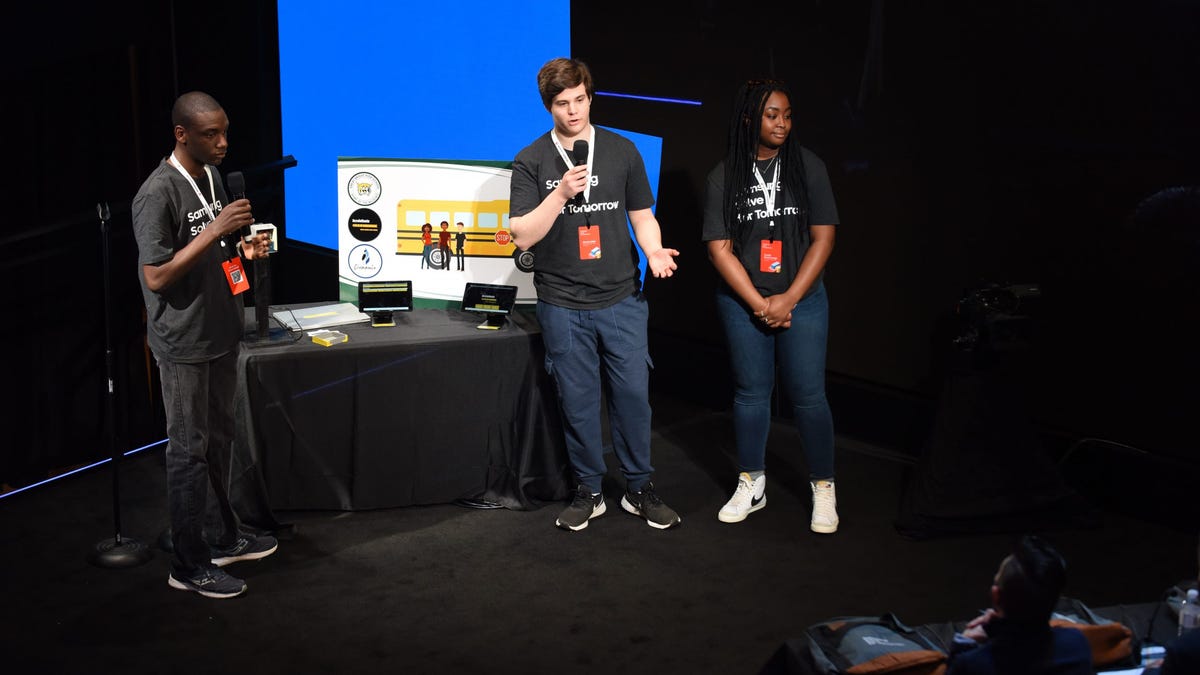Students Combat Driver Shortages and Food Waste in Samsung's STEM Contest
The winning projects focused on planning more efficient bus routes, repurposing food waste and improving school safety.

Students at Great Bridge High School in Chesapeake, Virginia present their project for helping school buses to plan more efficient routes.
Camille Kersha-Aerga grew tired of seeing her fellow classmates arrive to school late because of bus delays resulting from a driver shortage. "It just wasn't fair that they were having a lesser opportunity than all of the other students," she said.
That prompted Kersha-Aerga and a group of students at Great Bridge High School in Chesapeake, Virginia to come up with an idea. They invented a system that calculates the most efficient bus route based on the students' addresses, inspired by FedEx's planning system. All students have to do is swipe a card when boarding, which then helps an accompanying app determine the best route.
The Great Bridge High School students are one of three teams selected as national winners in Samsung's $2 million competition called Solve for Tomorrow. The nationwide contest challenges students in grades 6 through 12 to solve local issues through original STEM projects. Tuesday's three winners each received $100,000 in Samsung technology and classroom supplies.
The winners were selected after a Shark Tank-style competition on Monday, in which students pitched their inventions and answered questions in front of a panel of judges. The other winning projects from New Jersey's Princeton High School and Porter High School in Texas focused on limiting food waste and improving school safety.
This year's competition marks the 12th annual Solve for Tomorrow contest. Ann Woo, senior director of corporate citizenship for Samsung Electronics America, pointed to Great Bridge's project as an example of a subject that directly impacts communities but has also become an issue of national importance. "It really is the voice of the students and classrooms all around the country," Woo said. "So over the years, we get to hear what they care about."
The winning project from Porter High School in Texas seeks to improve school evacuation processes. The students invented a system that uses a mesh network of microcontrollers, audio sensors and light sensors to detect active shooters and relay information accordingly. The microcontrollers activate a system of LED lights that can guide students to safety and change in color depending on the threat level. The students were inspired to create the system after false rumors of a shooter created panic at a dance last fall.
"We have these drills that are for students within enclosed classrooms," said Johann Carranza, one of the Porter High students who worked on the project. "But we have nothing in place for evacuation within these larger confined areas. "
Princeton High School students came up with a way to use bugs called black soldier flies to repurpose food waste and reduce greenhouse gas emissions. The students found a way to use oil from the black soldier flies to replace palm oil in cosmetic products like soap.
Samsung's Solve for Tomorrow is one of several efforts by big tech companies to support students interested in technology and science. Apple provides coding curriculum resources for students through its Everyone Can Code program, while Microsoft's Minecraft for Education can be used to teach kids about everything from math to history and climate change through the popular building game.

